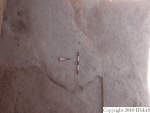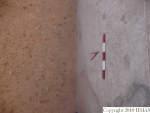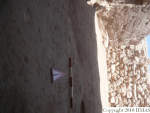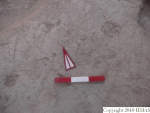| Best image | 2009-9-9 | cJC |  v174 |
| Category | 2009-8-9 | !! | build-up |
| Definition | 2009-8-9 | cJC | accumulation D |
| Summary | 2009-9-9 | cJC | Gray laminations on top of the northern portion of f339. This feature is very flaky and comes apart easily. |
| Best image | 2009-9-9 | cJC |  v174 |
| Description | 2009-8-9 | cJC | gray flakey layer on top of f339. The layers are very thin and come apart easily. |
| Daily | 2009-8-9 | cJC | At this point it is unclear if this feature is the same as f339 but damaged by water or if it is a series of thin accumulations on top of f339. Today we began excavating this feature but did not recover any pottery so there is no q-lot. |
| Argument | 2009-8-19 | cJC | This feature was a thin flaky layer immediately on top of f339 that separated easily. It appears to be a damaged portion of f339 rather than a separate deposition. Because f339 is thought to be the moment after the erosion ( f366) when a harder 'crust' developed on top of the eroded layers it seems plausible that these accumulations on top are part of the erosion and formation of the crust ( f339) before the brickfall ( f338, f341). |
| Evolution | 2009-8-29 | cJC | This layer of thin laminations is probably part of the same depositional process that created all the small laminations in the southeast corner of k14, f354. It is likely that f354 and f371 are the same or at least created by the same process. |
| Locus | 2009-8-9 | cJC | k15 |
| Elevation | 2009-8-9 | cJC | 8721 @bottom |
| 2009-8-9 | cJC | 8729 @top |
| Type of contact: Earliest events | 2009-8-29 | cJC | f371 overlays f339 (floor B) |
| 2009-8-30 | cJC | f371 overlays f339 (floor B) | |
| 2009-8-9 | cJC | f371 overlays f372 (brickfall) | |
| Inclusions | 06-09-2016 | !! | frequencies of ceramic vessels and sherds included within feature |
| Stratum to which element belongs | 2011-11-11 | cJC | s161J2B |
| Phase to which stratum belongs | 2011-11-11 | cJC | h7jJ2B |
| Stratigraphic reasons | 2009-9-16 | cJC | Probably part of f339, this feature is associated with early Mittani erosion. |
| Other reasons | 2011-11-21 | cJC | Part of erosion processes. Inconclusively dated as there is no pottery but it seems to be damaged by erosion. It could possibly be a third millennium floor damaged by erosion but for now it has been attributed to the period of erosion. |
| Ware/Material | 2009-8-9 | cJC | clay |
| Color definition | 2009-8-9 | cJC | gray |
| Hardness | 2009-8-9 | cJC | soft |
| Texture | 2009-8-9 | cJC | flaky |
| Photo of view |  v174  v174a  v174b  v174c |
| Storage | 2009-8-9 | cJC | T810 |